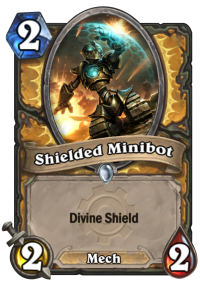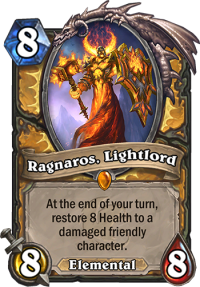Nowadays, Uther’s versatility is showcased by the various hero power upgrades bestowed upon us by The Witchwood – and while Paladin is certainly in a renaissance period of sorts thanks to its multiple strong archetypal options, perhaps the most mouth-watering prospect of Rastakhan’s Rumble is the potential return of the deck that started it all: Control Paladin, a monster of the Classic meta.
Vanilla is the Best Flavor
I always like to compare the old Control Paladin – or “Healadin”, if you will – with Jade Druid, except for the fact that its infinitely generated minions were always 1/1s instead of the 1-mana monstrosities the Jade Idols spawned by the time the game reached its final stages. Functionally, they filled in a very similar role: Healadin was on the absolute edge of the spectrum in terms of control archetypes, comfortably beating both Warrior and Priest in long, grindy matchups while struggling against aggro. (For the purposes of the above comparison, let’s stick with the pre-KotFT iteration of Jade Druid when the class wasn’t inexplicably granted a plethora of tools to make up for its baked-in weaknesses against swarmy decks.)

The gameplan was simple: go card for card in the slow matchups, making use of your hero power as often as possible along the way to generate extra resources compared to the armor or health regeneration offered up by the aforementioned classes. Every time they had to use a card to deal with your 1/1 dudes, you were a step closer to victory: you didn’t need a threat of Level Up! or a Quartermaster to get things done as the foes would eventually bleed to death by a thousand paper cuts. Of course, the class’ janky hard removal and combo-based AoE options in the Classic set made things pretty difficult against aggressive decks, which is why the archetype also featured copious amounts of heal in the form of cards like Lay on Hands and – something that would seem absolutely impossible today – Holy Light. Yes, that card actually saw competitive play around the dawn of Hearthstone. And yes, Harvest Golem used to be a premium minion, way before the Mech tag was even added to the game!
It happens to be my favorite deck of all time. Grinding out games and matching your opponent card for card, having full information about their tools and yours is the sort of gameplay experience I enjoy a lot. Unfortunately, Hearthstone’s conscious move away from this style of battling has also led to the erosion and eventual downfall of the archetype – however, a new dawn may just be upon us.
The Corrupted Ashbringer
The Curse of Naxxramas and its focus on Deathrattle synergies – meaning Yeti-sized Undertakers and incredibly sticky boards – pretty much amounted to a kick in the balls to this kind of a Paladin deck. However, its eventual disappearance was due to evolution, not decay: the fabled Zombie Chow–Shielded Minibot–Muster for Battle–Piloted Shredder quartet opener made available by Goblins versus Gnomes pushed the deck towards a more midrange-y, proactive approach, a process which eventually culminated in Secret Paladin during the TGT era where many decried it as the ultimate Curvestone strategy, trying to string together the best individual mininons in their mana slot all the way up to Tirion Fordring in what essentially amounted to auto-wins in many cases. Dedicated Control builds still cropped up as occasional alternatives but could never hold a candle to the explosive capabilities of Mysterious Challenger and his many little friends.

Once the Standard rotation kicked in, the class’ core set pretty much set the tone again: an odd hodge-podge of control tools that are almost but not quite capable of creating a workable archetype by themselves. Control Paladin was back during the early days of Whispers of the Old Gods until it was eventually outclassed by C’Thun Warrior and other decks in the same department, using N'Zoth, The Corruptor to generate degenerate boards as a value tool on top of its usual armaments. This basically marked the beginning of Team 5’s conscious effort to switch control decks from a resource exhaustion plan to a resource generation strategy instead, a process which has continued to this day with a plethora of cards like Kazakus, Jade Idol, the quests and the Death Knights – perhaps the most egregious example of this phenomenon – , not to mention the upgraded Hero Powers plus the powerful combo finishers that always had a field day against Control Paladins.

That’s not saying the archetype wasn’t getting support: Spikeridged Steed and Sunkeeper Tarim are fantastic cards, it’s just that they work even better in different, more potent Paladin decks. Uther of the Ebon Blade is not a bad card, it’s just that basically every other Death Knight happen to be even more blatant in its value generation. Benevolent Djinn and Lynessa Sunsorrow seem like the perfect cards for a control deck like this, but, again, they aren’t enough when there’s such a power gap to close. I would have killed for Crystalsmith Kangor or Shrink Ray in the Classic set: no traction just yet. The real problem with Control Paladin is the lack of a dedicated finisher – again, exactly its main source of appeal in my eyes –, something which makes it hopelessly outmatched against every Death Knight and cards like Omega Assembly that comfortably outdo your steady stream of Recruits.
Still, there’s reason for optimism: not just because of the impending rotation where we say goodbye to most of the hero cards but specifically due to the pretty nutty cards coming up in Rastakhan’s Rumble that are very clearly meant to be a serious push to get this old stalwart back on his feet.
A Bright Future?
There’s no denying that the field is pretty stacked right now with a multitude of high-powered archetypes competing for a place in the metagame: it’s not at all guaranteed that Control Paladin will actually get to shine before the Year of the Raven ends. But holy moly, some of these cards made me inadvertently salivate all over my keyboard.
Shirvallah, the Tiger didn’t exactly get rave reviews upon its reveal but its exactly the sort of card that you’ll need to see in action to truly appreciate it. It removes a minion, heals for 7 health and places a decent-sized presence on the board (not counting any buffs): it basically does everything Ultimate Infestation has to offer sans the card draw, meaning it’s still a fantastic control tool, especially if you get to cast it for an unexpectedly low price in the early game. It’s proper hard removal for Paladin with benefits – it will be a nightmare to face if you’re running any sort of tempo strategy.

Time Out! is understandably compared to Ice Block in an unfavorable manner but an important consideration is that Paladin will keep up with you on the board (unlike Freeze Mage-like strategies), making it more likely that this spell will actually help them turn around the game provided it’s cast under the right condition – not to mention that it can also be a part of a weapon-based clear without its usual downside. Zandalari Templar is a lovely alternative take on Hooked Reaver – itself a variation of a taunted Molten Giant – and Immortal Prelate is just stupid. How fitting is it that the class perhaps most tormented by Jade Druid gets its own! You will simply not have enough Silences and transformation effect for all the targets in a slow Paladin deck.
A special note must go out to the lovely reference that is A New Challenger... – while it’s likely not good enough to see play, it’s worth mentioning that the increased odds of discovering an appropriate class card means that you may end up with a Blackguard often enough to consider it at least as an experimental inclusion. Yes, that card is still a thing.
Last but not least, High Priest Thekal is a very appropriate answer for Hearthstone’s long-running issue about Armor’s superiority to health gain: simply put, classes like Priest or Paladin are now at an endemic disadvantage in an environment where combo decks can generate as incredibly high damage levels as they are capable of right now, and this card allows the latter to stack up to a pretty high life total overall. Additionally, it lets you pull off the healing-based synergies even in slow matchups where your health total is generally not affected as much during the slow battle.
You may very well say that I’m biased or overhyped: we’re talking about my favorite archetype of all time, after all. For what it’s worth, this is truly the first time since the game’s release that we’re getting multiple cards in a single set that are dedicated to help Control Paladin, and if you got this far in this article, it might be time for you to get excited as well.

[…] in a slow match. While that strategy has lost a lot of its relevance over the years – you can find out more about that in this article –, there are quite a few star cards in the upcoming set that will likely make the archetype […]
The main problem with Control Pally in the recent rotations is that it always got outvalued by other Control decks, and Combo decks always beat it. The wincon of DK Uther turned out to be too slow vs the likes of DK Rexxar, DK Jaina or DK Gul’Dan. If it had been 3 horsemen instead of 4, maybe it would have been different (but the flavor would have been ruined, it’s the 4 horsemen of the Apocalypse, after all). Shirvalah + Baleful Banker + Holy Wrath after drawing your deck is a beginning of a wincon for Control Paladin, maybe it’s not good enough right now, but who knows after rotation once all those value-generating DKs are out of Standard?
Great Article, right there with ya, slow pally for life!
That was a very enjoable read. I could definitely recognize myself in the article, as old control paladin is my favourite deck to date. The rastakhan rumble seems promising so far.
Such a nice article ! Keep it up sir 🙂
Too bad Blizzard doesn’t see Paladin needs board clears, spells, removal, better DK. Anything BUT healing, no matter how much you heal, if you can’t control the board health/armor can only save you about 2 extra turns.